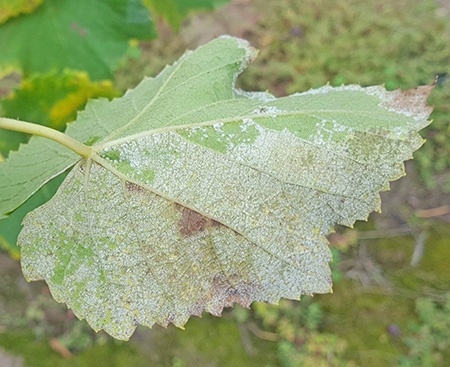What can be done for late season downy mildew on grapes?
Leaf loss due to late season downy mildew impacts fruit quality and reduces winter hardiness and next year’s growth.

Several episodes of hot and humid weather in Michigan has allowed downy mildew to become a severe problem in some areas of northwest and southwest Michigan (see photos). Downy mildew can be found on leaves and clusters and is caused by the fungal-like pathogen, Plasmopara viticola. Severe downy mildew will defoliate grape plants by killing the leaves. Downy mildew can also damage fruit and cause off-flavors. Increasing canopy airflow, exposure to light and decreasing wetness are the best cultural practices for controlling downy mildew. Downy mildew spores are inactivated after 5-7 hours in sunlight, so most infections occur in the morning.
Downy mildew infections occur during the season as early as two to three weeks before bloom. The real risk is later in the season when warm, wet, humid conditions are common. Early control is critical for controlling downy mildew. Late in the season when we have heavy dews every morning, downy mildew can really explode. Severe leaf loss before harvest due to downy mildew is a common problem in Michigan.
In terms of managing downy mildew with fungicides, there are three phases:
- Infection before visible symptoms, when protectants can be used,
- Visible symptoms, when curative products can be applied.
- Sporulation, when only eradicants are effective.
This close to harvest with sporulating downy mildew in the vineyards, we are in the sporulation phase of the disease.

When considering late season fungicides for downy mildew, the main concerns are effectiveness, the FRAC (Fungicide Resistance Action Codes) and the pre-harvest interval. Fungicide Resistance Action Codes group together active ingredients which demonstrate potential for cross resistance.
Below is a list of your control options. Remember to follow all label directions, especially the pre-harvest intervals, when you make an application.
- 30 day pre-harvest interval products: Ranman (FRAC 21), Reason (FRAC 11)
- 21 day pre-harvest interval products: Presidio (FRAC 43)
- 14 day pre-harvest interval products: Pristine (FRAC 11 + 7), Abound (FRAC 11), Quadris Top (FRAC 11 + 3), Revus (FRAC 40), Sovran (FRAC 11) and Flint (FRAC 11)
- 0 day pre-harvest interval products: Captan (48-hour reentry interval, FRAC M4), Phosphorus acids (FRAC 33) and Copper (FRAC M1)
Currently, we have heavy disease pressure in the vineyards with many active sporulating lesions and heavy dews every morning. This late in the season, many growers are using back to back applications of phosphorus acid products to burn out active downy mildew lesions and stop the spread of the disease. Using the curative strobilurin fungicides (FRAC 11) alone under heavy disease pressure will only slow the spread of the disease. These products do not remove the sporulating lesions causing the disease. The FRAC 11 fungicides are very susceptible to resistance. Using these products alone will lead to resistance to these fungicides in downy mildew.
When downy mildew defoliates the vine, it decreases the vine’s ability to ripen fruit. Growers focus on saving this year’s crop. Defoliation also has long-term effects. Maintaining healthy leaves is critical for consistent year-to-year grape production. The leaves supply the carbohydrates needed to mature wood in the fall. When downy mildew defoliates the vine, it decreases cold acclimation of the over-wintering vine. All the above-ground parts are affected. The trunks, cordons, canes and buds are all weakened and have reduced reserves going into winter. Early defoliation weakens the vine and reduces next year’s vegetative growth and crop.



 Print
Print Email
Email

